Analysis of Woolworth's Financial Statements: Ratio, Horizontal, and Vertical Analysis
VerifiedAdded on 2023/01/11
|13
|2591
|53
AI Summary
This report provides a detailed analysis of Woolworth's financial statements using ratio, horizontal, and vertical analysis. It examines the company's performance and position over time, highlighting its profitability, liquidity, efficiency, leverage, and more.
Contribute Materials
Your contribution can guide someone’s learning journey. Share your
documents today.
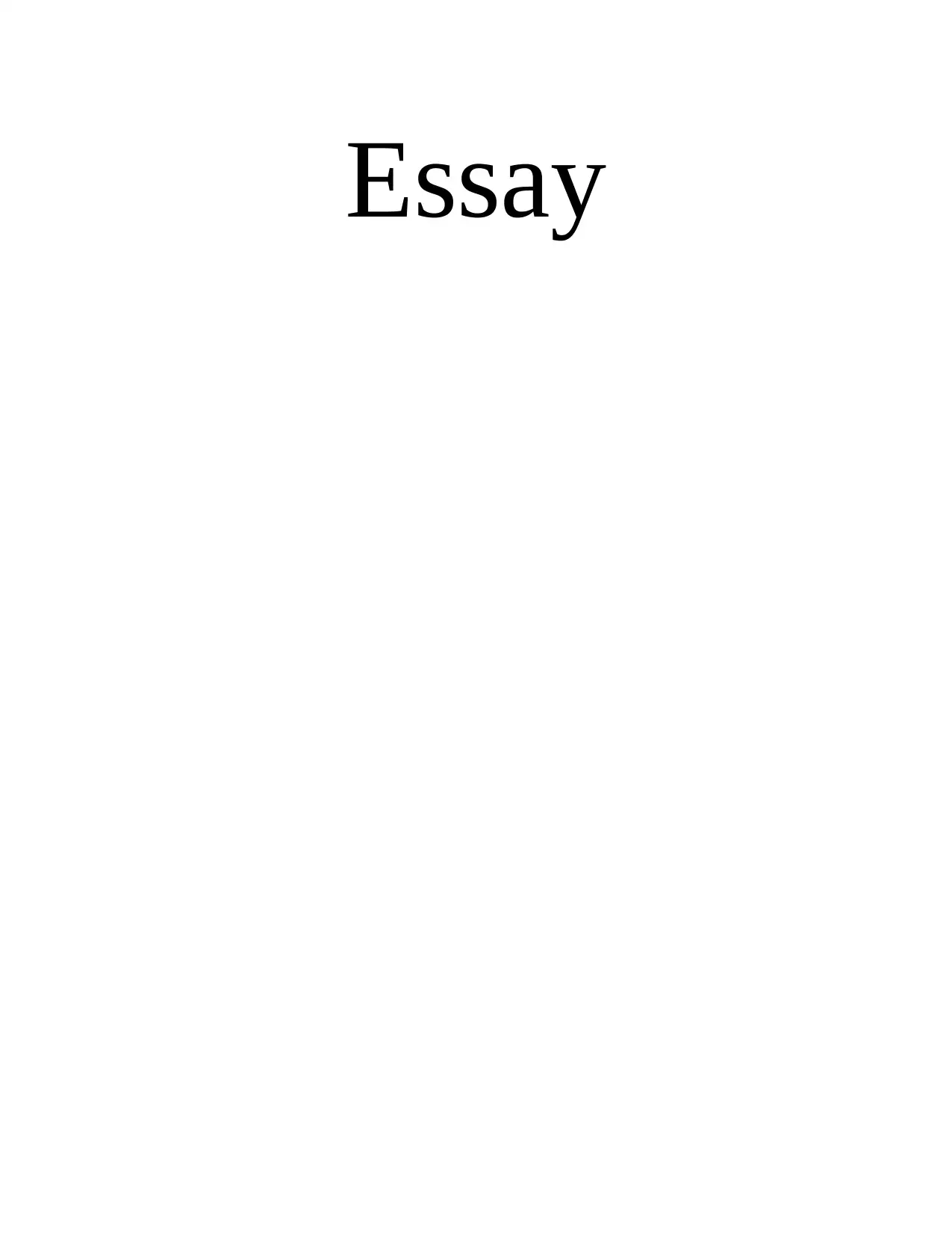
Essay
Secure Best Marks with AI Grader
Need help grading? Try our AI Grader for instant feedback on your assignments.
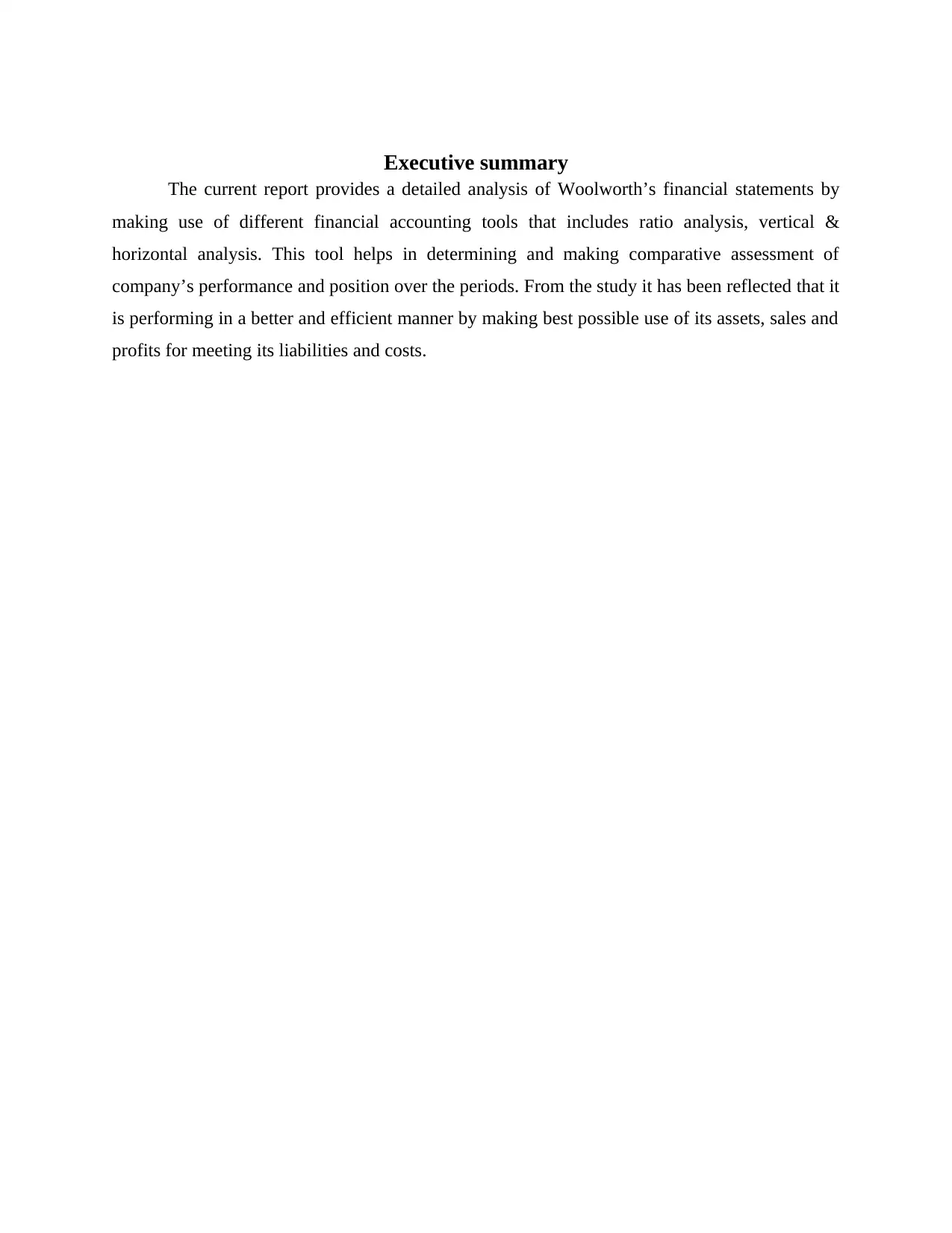
Executive summary
The current report provides a detailed analysis of Woolworth’s financial statements by
making use of different financial accounting tools that includes ratio analysis, vertical &
horizontal analysis. This tool helps in determining and making comparative assessment of
company’s performance and position over the periods. From the study it has been reflected that it
is performing in a better and efficient manner by making best possible use of its assets, sales and
profits for meeting its liabilities and costs.
The current report provides a detailed analysis of Woolworth’s financial statements by
making use of different financial accounting tools that includes ratio analysis, vertical &
horizontal analysis. This tool helps in determining and making comparative assessment of
company’s performance and position over the periods. From the study it has been reflected that it
is performing in a better and efficient manner by making best possible use of its assets, sales and
profits for meeting its liabilities and costs.
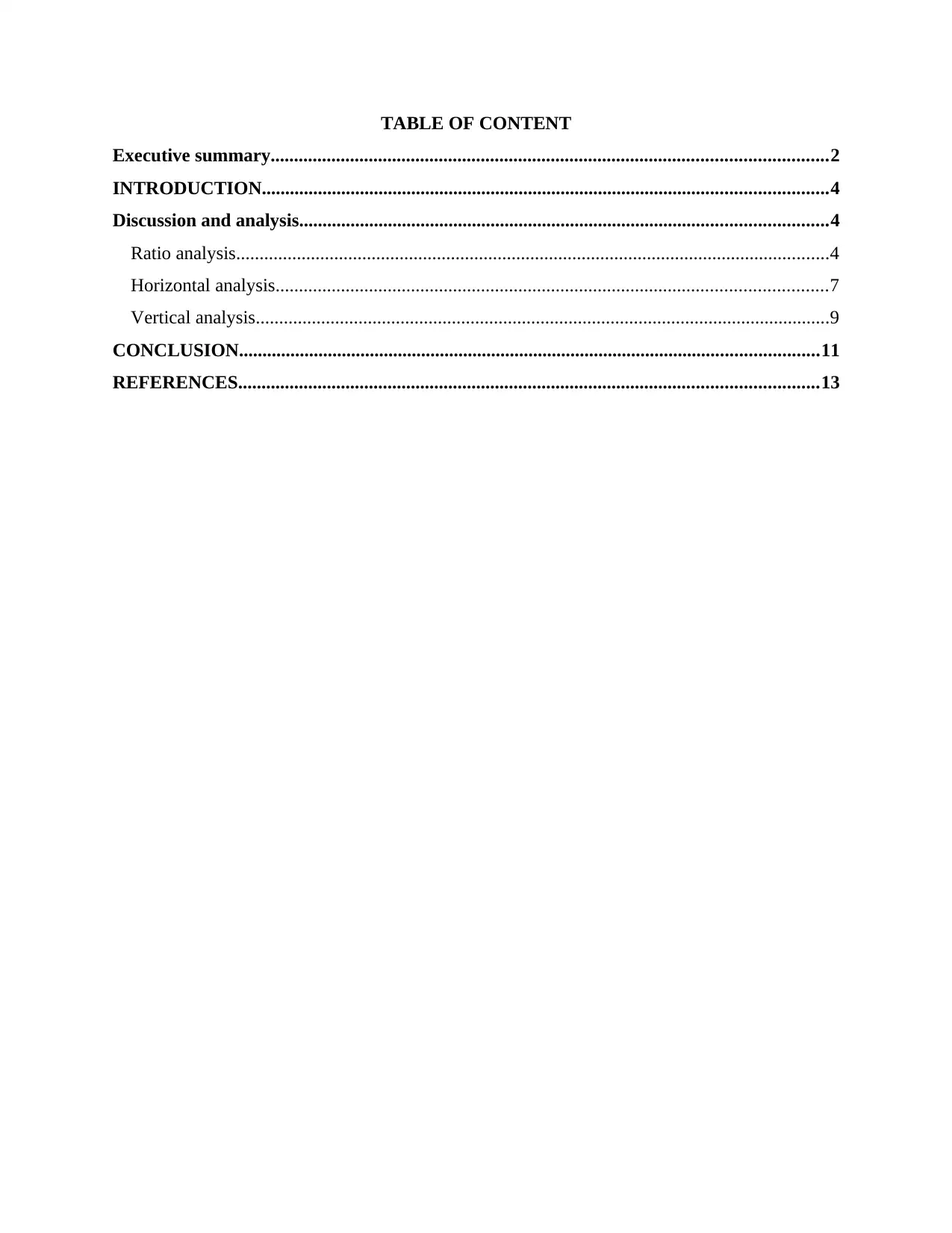
TABLE OF CONTENT
Executive summary.......................................................................................................................2
INTRODUCTION.........................................................................................................................4
Discussion and analysis.................................................................................................................4
Ratio analysis...............................................................................................................................4
Horizontal analysis......................................................................................................................7
Vertical analysis...........................................................................................................................9
CONCLUSION............................................................................................................................11
REFERENCES............................................................................................................................13
Executive summary.......................................................................................................................2
INTRODUCTION.........................................................................................................................4
Discussion and analysis.................................................................................................................4
Ratio analysis...............................................................................................................................4
Horizontal analysis......................................................................................................................7
Vertical analysis...........................................................................................................................9
CONCLUSION............................................................................................................................11
REFERENCES............................................................................................................................13
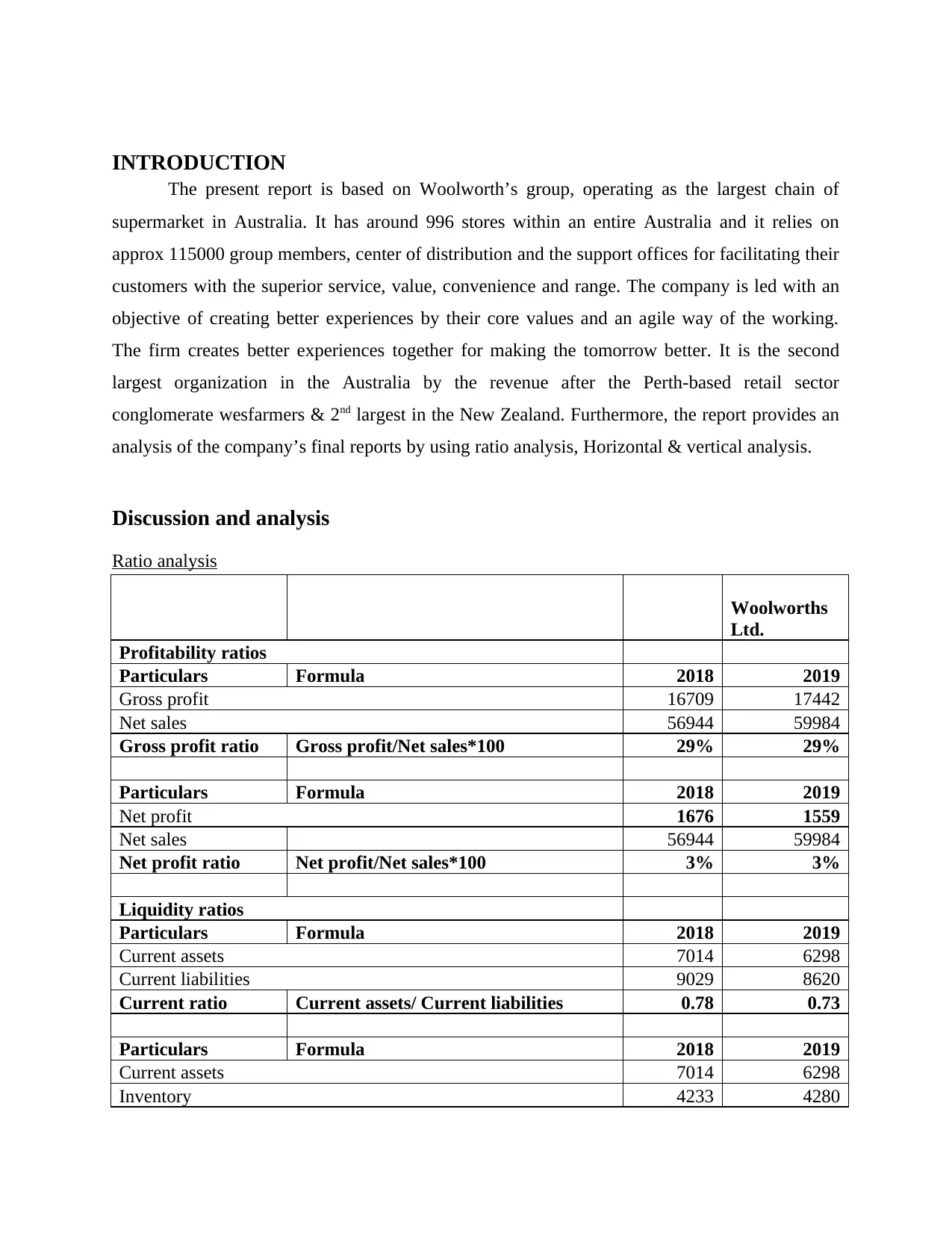
INTRODUCTION
The present report is based on Woolworth’s group, operating as the largest chain of
supermarket in Australia. It has around 996 stores within an entire Australia and it relies on
approx 115000 group members, center of distribution and the support offices for facilitating their
customers with the superior service, value, convenience and range. The company is led with an
objective of creating better experiences by their core values and an agile way of the working.
The firm creates better experiences together for making the tomorrow better. It is the second
largest organization in the Australia by the revenue after the Perth-based retail sector
conglomerate wesfarmers & 2nd largest in the New Zealand. Furthermore, the report provides an
analysis of the company’s final reports by using ratio analysis, Horizontal & vertical analysis.
Discussion and analysis
Ratio analysis
Woolworths
Ltd.
Profitability ratios
Particulars Formula 2018 2019
Gross profit 16709 17442
Net sales 56944 59984
Gross profit ratio Gross profit/Net sales*100 29% 29%
Particulars Formula 2018 2019
Net profit 1676 1559
Net sales 56944 59984
Net profit ratio Net profit/Net sales*100 3% 3%
Liquidity ratios
Particulars Formula 2018 2019
Current assets 7014 6298
Current liabilities 9029 8620
Current ratio Current assets/ Current liabilities 0.78 0.73
Particulars Formula 2018 2019
Current assets 7014 6298
Inventory 4233 4280
The present report is based on Woolworth’s group, operating as the largest chain of
supermarket in Australia. It has around 996 stores within an entire Australia and it relies on
approx 115000 group members, center of distribution and the support offices for facilitating their
customers with the superior service, value, convenience and range. The company is led with an
objective of creating better experiences by their core values and an agile way of the working.
The firm creates better experiences together for making the tomorrow better. It is the second
largest organization in the Australia by the revenue after the Perth-based retail sector
conglomerate wesfarmers & 2nd largest in the New Zealand. Furthermore, the report provides an
analysis of the company’s final reports by using ratio analysis, Horizontal & vertical analysis.
Discussion and analysis
Ratio analysis
Woolworths
Ltd.
Profitability ratios
Particulars Formula 2018 2019
Gross profit 16709 17442
Net sales 56944 59984
Gross profit ratio Gross profit/Net sales*100 29% 29%
Particulars Formula 2018 2019
Net profit 1676 1559
Net sales 56944 59984
Net profit ratio Net profit/Net sales*100 3% 3%
Liquidity ratios
Particulars Formula 2018 2019
Current assets 7014 6298
Current liabilities 9029 8620
Current ratio Current assets/ Current liabilities 0.78 0.73
Particulars Formula 2018 2019
Current assets 7014 6298
Inventory 4233 4280
Secure Best Marks with AI Grader
Need help grading? Try our AI Grader for instant feedback on your assignments.
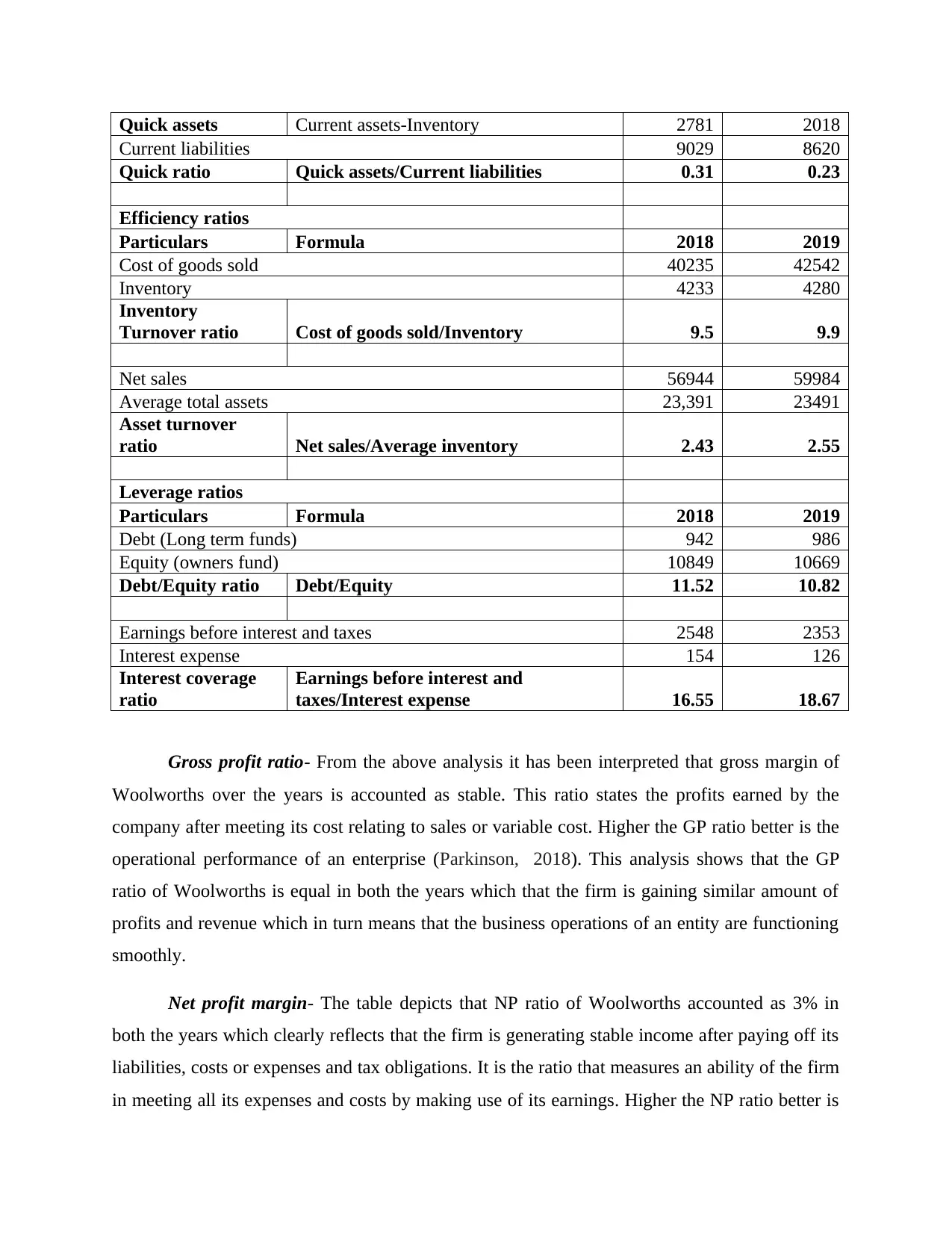
Quick assets Current assets-Inventory 2781 2018
Current liabilities 9029 8620
Quick ratio Quick assets/Current liabilities 0.31 0.23
Efficiency ratios
Particulars Formula 2018 2019
Cost of goods sold 40235 42542
Inventory 4233 4280
Inventory
Turnover ratio Cost of goods sold/Inventory 9.5 9.9
Net sales 56944 59984
Average total assets 23,391 23491
Asset turnover
ratio Net sales/Average inventory 2.43 2.55
Leverage ratios
Particulars Formula 2018 2019
Debt (Long term funds) 942 986
Equity (owners fund) 10849 10669
Debt/Equity ratio Debt/Equity 11.52 10.82
Earnings before interest and taxes 2548 2353
Interest expense 154 126
Interest coverage
ratio
Earnings before interest and
taxes/Interest expense 16.55 18.67
Gross profit ratio- From the above analysis it has been interpreted that gross margin of
Woolworths over the years is accounted as stable. This ratio states the profits earned by the
company after meeting its cost relating to sales or variable cost. Higher the GP ratio better is the
operational performance of an enterprise (Parkinson, 2018). This analysis shows that the GP
ratio of Woolworths is equal in both the years which that the firm is gaining similar amount of
profits and revenue which in turn means that the business operations of an entity are functioning
smoothly.
Net profit margin- The table depicts that NP ratio of Woolworths accounted as 3% in
both the years which clearly reflects that the firm is generating stable income after paying off its
liabilities, costs or expenses and tax obligations. It is the ratio that measures an ability of the firm
in meeting all its expenses and costs by making use of its earnings. Higher the NP ratio better is
Current liabilities 9029 8620
Quick ratio Quick assets/Current liabilities 0.31 0.23
Efficiency ratios
Particulars Formula 2018 2019
Cost of goods sold 40235 42542
Inventory 4233 4280
Inventory
Turnover ratio Cost of goods sold/Inventory 9.5 9.9
Net sales 56944 59984
Average total assets 23,391 23491
Asset turnover
ratio Net sales/Average inventory 2.43 2.55
Leverage ratios
Particulars Formula 2018 2019
Debt (Long term funds) 942 986
Equity (owners fund) 10849 10669
Debt/Equity ratio Debt/Equity 11.52 10.82
Earnings before interest and taxes 2548 2353
Interest expense 154 126
Interest coverage
ratio
Earnings before interest and
taxes/Interest expense 16.55 18.67
Gross profit ratio- From the above analysis it has been interpreted that gross margin of
Woolworths over the years is accounted as stable. This ratio states the profits earned by the
company after meeting its cost relating to sales or variable cost. Higher the GP ratio better is the
operational performance of an enterprise (Parkinson, 2018). This analysis shows that the GP
ratio of Woolworths is equal in both the years which that the firm is gaining similar amount of
profits and revenue which in turn means that the business operations of an entity are functioning
smoothly.
Net profit margin- The table depicts that NP ratio of Woolworths accounted as 3% in
both the years which clearly reflects that the firm is generating stable income after paying off its
liabilities, costs or expenses and tax obligations. It is the ratio that measures an ability of the firm
in meeting all its expenses and costs by making use of its earnings. Higher the NP ratio better is
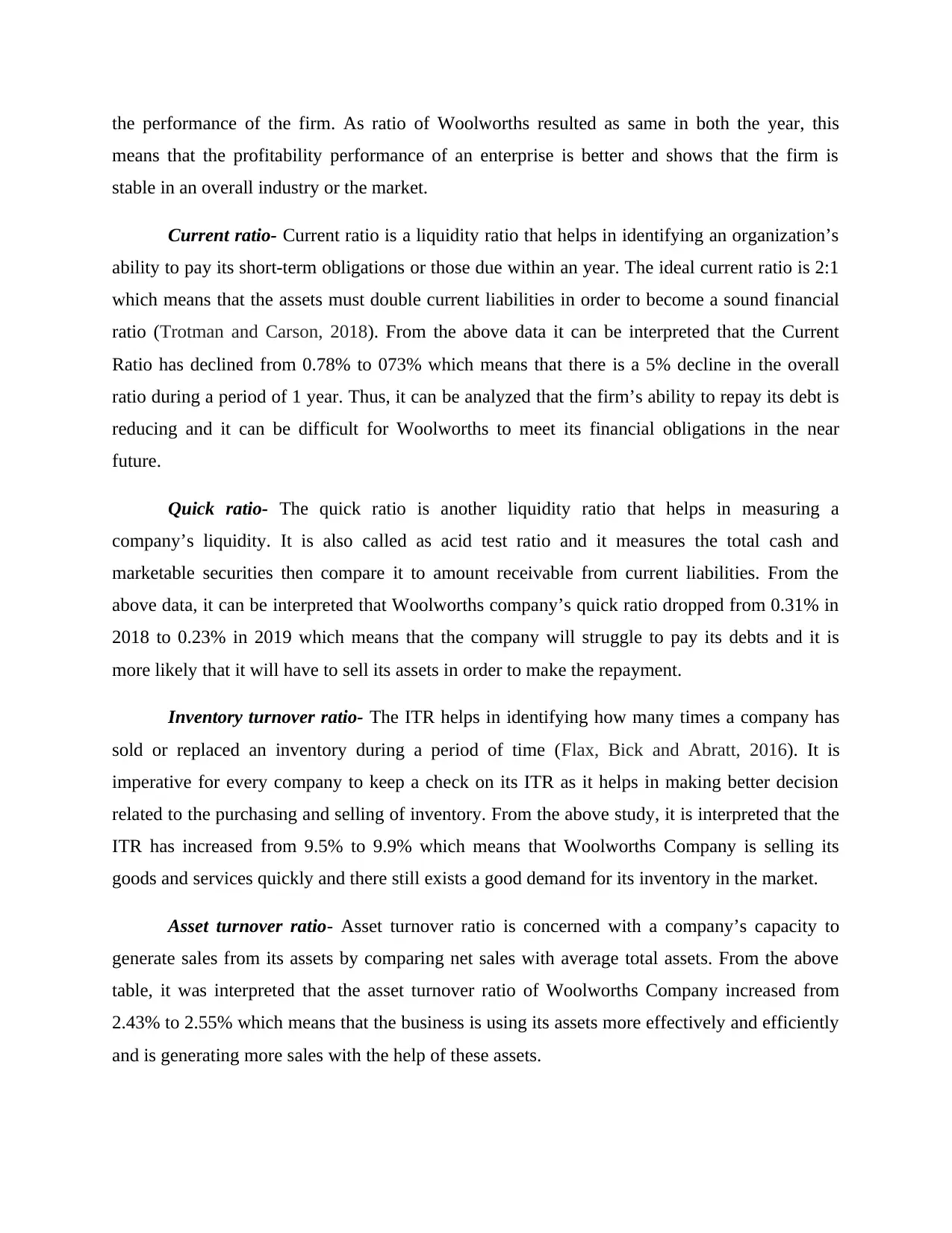
the performance of the firm. As ratio of Woolworths resulted as same in both the year, this
means that the profitability performance of an enterprise is better and shows that the firm is
stable in an overall industry or the market.
Current ratio- Current ratio is a liquidity ratio that helps in identifying an organization’s
ability to pay its short-term obligations or those due within an year. The ideal current ratio is 2:1
which means that the assets must double current liabilities in order to become a sound financial
ratio (Trotman and Carson, 2018). From the above data it can be interpreted that the Current
Ratio has declined from 0.78% to 073% which means that there is a 5% decline in the overall
ratio during a period of 1 year. Thus, it can be analyzed that the firm’s ability to repay its debt is
reducing and it can be difficult for Woolworths to meet its financial obligations in the near
future.
Quick ratio- The quick ratio is another liquidity ratio that helps in measuring a
company’s liquidity. It is also called as acid test ratio and it measures the total cash and
marketable securities then compare it to amount receivable from current liabilities. From the
above data, it can be interpreted that Woolworths company’s quick ratio dropped from 0.31% in
2018 to 0.23% in 2019 which means that the company will struggle to pay its debts and it is
more likely that it will have to sell its assets in order to make the repayment.
Inventory turnover ratio- The ITR helps in identifying how many times a company has
sold or replaced an inventory during a period of time (Flax, Bick and Abratt, 2016). It is
imperative for every company to keep a check on its ITR as it helps in making better decision
related to the purchasing and selling of inventory. From the above study, it is interpreted that the
ITR has increased from 9.5% to 9.9% which means that Woolworths Company is selling its
goods and services quickly and there still exists a good demand for its inventory in the market.
Asset turnover ratio- Asset turnover ratio is concerned with a company’s capacity to
generate sales from its assets by comparing net sales with average total assets. From the above
table, it was interpreted that the asset turnover ratio of Woolworths Company increased from
2.43% to 2.55% which means that the business is using its assets more effectively and efficiently
and is generating more sales with the help of these assets.
means that the profitability performance of an enterprise is better and shows that the firm is
stable in an overall industry or the market.
Current ratio- Current ratio is a liquidity ratio that helps in identifying an organization’s
ability to pay its short-term obligations or those due within an year. The ideal current ratio is 2:1
which means that the assets must double current liabilities in order to become a sound financial
ratio (Trotman and Carson, 2018). From the above data it can be interpreted that the Current
Ratio has declined from 0.78% to 073% which means that there is a 5% decline in the overall
ratio during a period of 1 year. Thus, it can be analyzed that the firm’s ability to repay its debt is
reducing and it can be difficult for Woolworths to meet its financial obligations in the near
future.
Quick ratio- The quick ratio is another liquidity ratio that helps in measuring a
company’s liquidity. It is also called as acid test ratio and it measures the total cash and
marketable securities then compare it to amount receivable from current liabilities. From the
above data, it can be interpreted that Woolworths company’s quick ratio dropped from 0.31% in
2018 to 0.23% in 2019 which means that the company will struggle to pay its debts and it is
more likely that it will have to sell its assets in order to make the repayment.
Inventory turnover ratio- The ITR helps in identifying how many times a company has
sold or replaced an inventory during a period of time (Flax, Bick and Abratt, 2016). It is
imperative for every company to keep a check on its ITR as it helps in making better decision
related to the purchasing and selling of inventory. From the above study, it is interpreted that the
ITR has increased from 9.5% to 9.9% which means that Woolworths Company is selling its
goods and services quickly and there still exists a good demand for its inventory in the market.
Asset turnover ratio- Asset turnover ratio is concerned with a company’s capacity to
generate sales from its assets by comparing net sales with average total assets. From the above
table, it was interpreted that the asset turnover ratio of Woolworths Company increased from
2.43% to 2.55% which means that the business is using its assets more effectively and efficiently
and is generating more sales with the help of these assets.
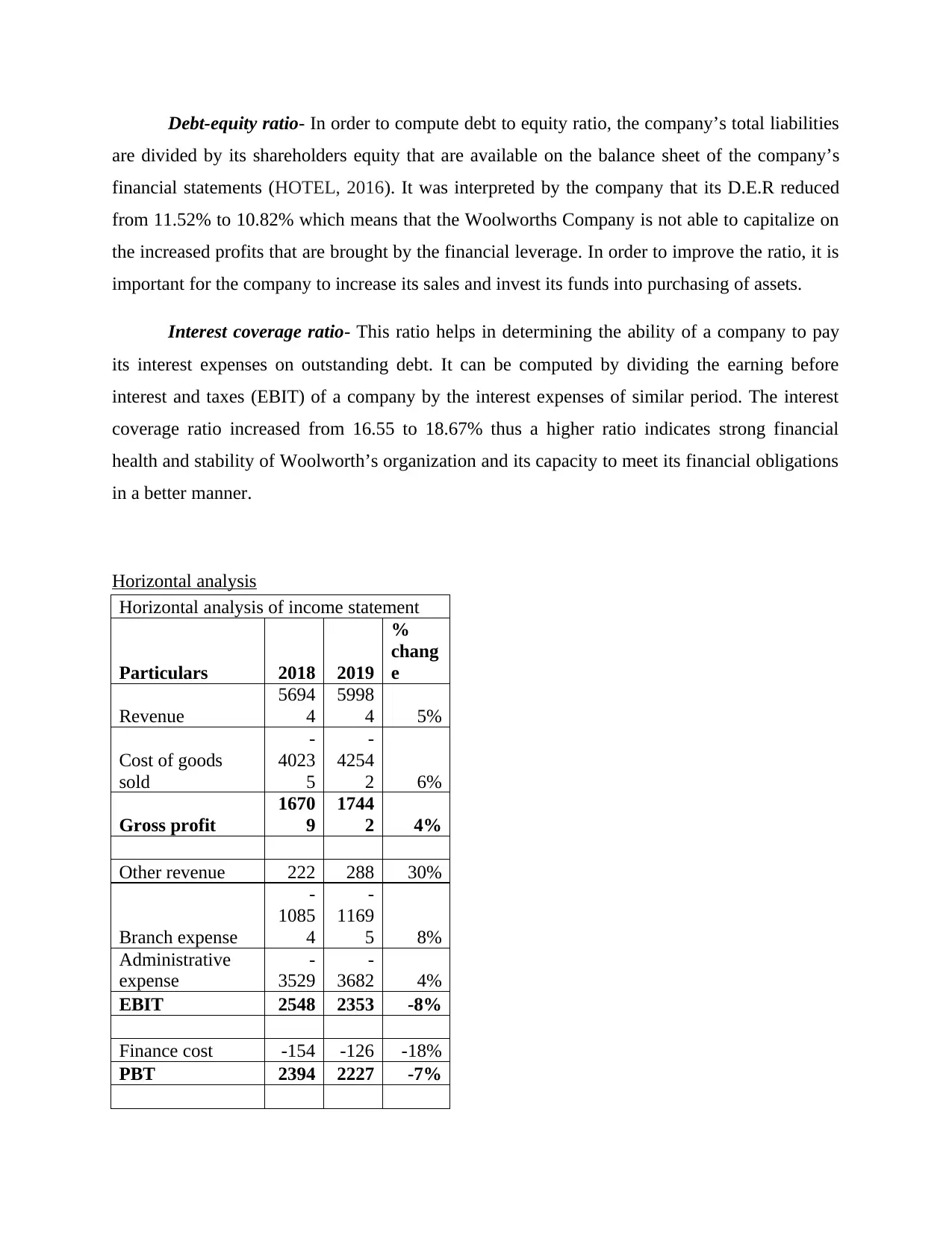
Debt-equity ratio- In order to compute debt to equity ratio, the company’s total liabilities
are divided by its shareholders equity that are available on the balance sheet of the company’s
financial statements (HOTEL, 2016). It was interpreted by the company that its D.E.R reduced
from 11.52% to 10.82% which means that the Woolworths Company is not able to capitalize on
the increased profits that are brought by the financial leverage. In order to improve the ratio, it is
important for the company to increase its sales and invest its funds into purchasing of assets.
Interest coverage ratio- This ratio helps in determining the ability of a company to pay
its interest expenses on outstanding debt. It can be computed by dividing the earning before
interest and taxes (EBIT) of a company by the interest expenses of similar period. The interest
coverage ratio increased from 16.55 to 18.67% thus a higher ratio indicates strong financial
health and stability of Woolworth’s organization and its capacity to meet its financial obligations
in a better manner.
Horizontal analysis
Horizontal analysis of income statement
Particulars 2018 2019
%
chang
e
Revenue
5694
4
5998
4 5%
Cost of goods
sold
-
4023
5
-
4254
2 6%
Gross profit
1670
9
1744
2 4%
Other revenue 222 288 30%
Branch expense
-
1085
4
-
1169
5 8%
Administrative
expense
-
3529
-
3682 4%
EBIT 2548 2353 -8%
Finance cost -154 -126 -18%
PBT 2394 2227 -7%
are divided by its shareholders equity that are available on the balance sheet of the company’s
financial statements (HOTEL, 2016). It was interpreted by the company that its D.E.R reduced
from 11.52% to 10.82% which means that the Woolworths Company is not able to capitalize on
the increased profits that are brought by the financial leverage. In order to improve the ratio, it is
important for the company to increase its sales and invest its funds into purchasing of assets.
Interest coverage ratio- This ratio helps in determining the ability of a company to pay
its interest expenses on outstanding debt. It can be computed by dividing the earning before
interest and taxes (EBIT) of a company by the interest expenses of similar period. The interest
coverage ratio increased from 16.55 to 18.67% thus a higher ratio indicates strong financial
health and stability of Woolworth’s organization and its capacity to meet its financial obligations
in a better manner.
Horizontal analysis
Horizontal analysis of income statement
Particulars 2018 2019
%
chang
e
Revenue
5694
4
5998
4 5%
Cost of goods
sold
-
4023
5
-
4254
2 6%
Gross profit
1670
9
1744
2 4%
Other revenue 222 288 30%
Branch expense
-
1085
4
-
1169
5 8%
Administrative
expense
-
3529
-
3682 4%
EBIT 2548 2353 -8%
Finance cost -154 -126 -18%
PBT 2394 2227 -7%
Paraphrase This Document
Need a fresh take? Get an instant paraphrase of this document with our AI Paraphraser
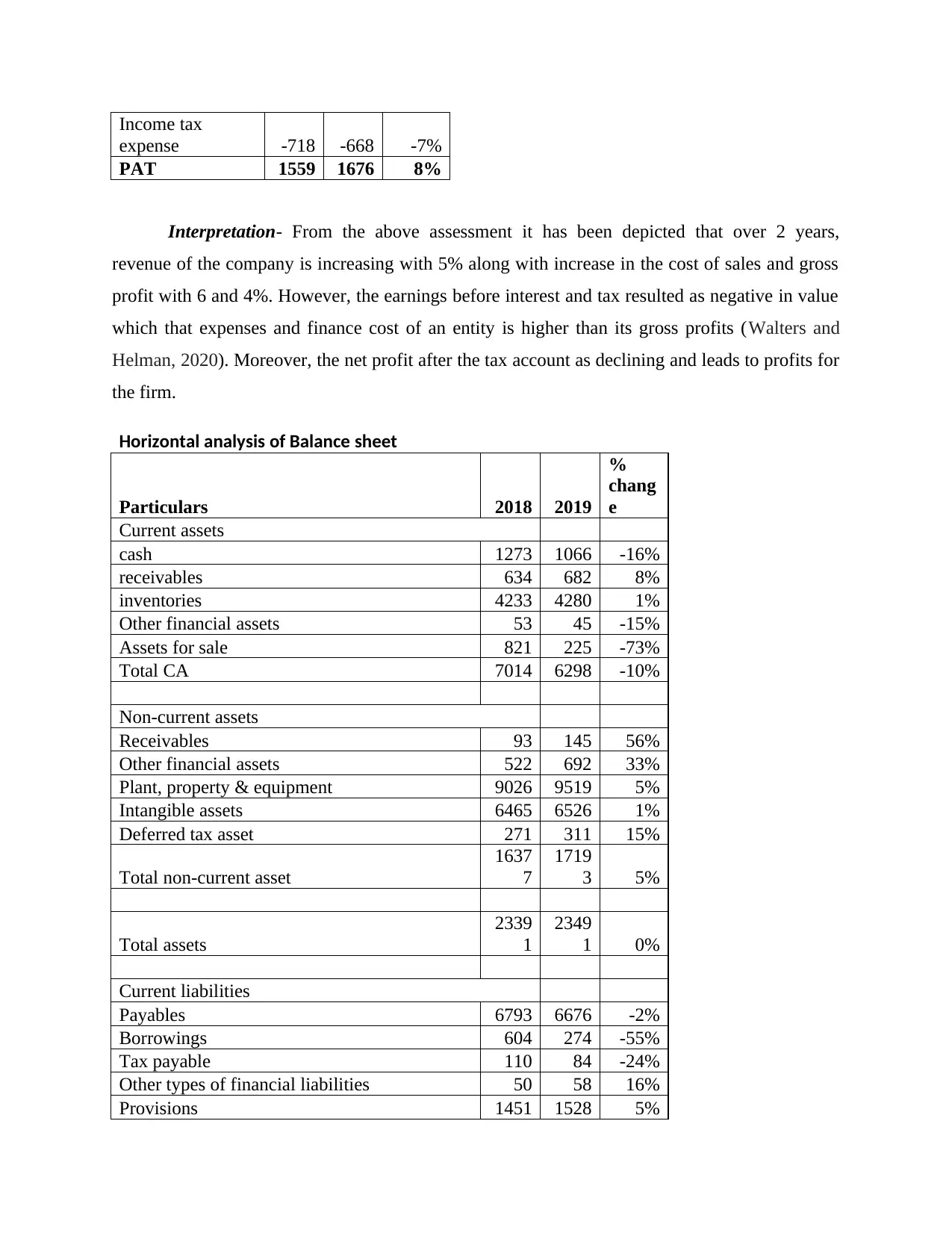
Income tax
expense -718 -668 -7%
PAT 1559 1676 8%
Interpretation- From the above assessment it has been depicted that over 2 years,
revenue of the company is increasing with 5% along with increase in the cost of sales and gross
profit with 6 and 4%. However, the earnings before interest and tax resulted as negative in value
which that expenses and finance cost of an entity is higher than its gross profits (Walters and
Helman, 2020). Moreover, the net profit after the tax account as declining and leads to profits for
the firm.
Horizontal analysis of Balance sheet
Particulars 2018 2019
%
chang
e
Current assets
cash 1273 1066 -16%
receivables 634 682 8%
inventories 4233 4280 1%
Other financial assets 53 45 -15%
Assets for sale 821 225 -73%
Total CA 7014 6298 -10%
Non-current assets
Receivables 93 145 56%
Other financial assets 522 692 33%
Plant, property & equipment 9026 9519 5%
Intangible assets 6465 6526 1%
Deferred tax asset 271 311 15%
Total non-current asset
1637
7
1719
3 5%
Total assets
2339
1
2349
1 0%
Current liabilities
Payables 6793 6676 -2%
Borrowings 604 274 -55%
Tax payable 110 84 -24%
Other types of financial liabilities 50 58 16%
Provisions 1451 1528 5%
expense -718 -668 -7%
PAT 1559 1676 8%
Interpretation- From the above assessment it has been depicted that over 2 years,
revenue of the company is increasing with 5% along with increase in the cost of sales and gross
profit with 6 and 4%. However, the earnings before interest and tax resulted as negative in value
which that expenses and finance cost of an entity is higher than its gross profits (Walters and
Helman, 2020). Moreover, the net profit after the tax account as declining and leads to profits for
the firm.
Horizontal analysis of Balance sheet
Particulars 2018 2019
%
chang
e
Current assets
cash 1273 1066 -16%
receivables 634 682 8%
inventories 4233 4280 1%
Other financial assets 53 45 -15%
Assets for sale 821 225 -73%
Total CA 7014 6298 -10%
Non-current assets
Receivables 93 145 56%
Other financial assets 522 692 33%
Plant, property & equipment 9026 9519 5%
Intangible assets 6465 6526 1%
Deferred tax asset 271 311 15%
Total non-current asset
1637
7
1719
3 5%
Total assets
2339
1
2349
1 0%
Current liabilities
Payables 6793 6676 -2%
Borrowings 604 274 -55%
Tax payable 110 84 -24%
Other types of financial liabilities 50 58 16%
Provisions 1451 1528 5%
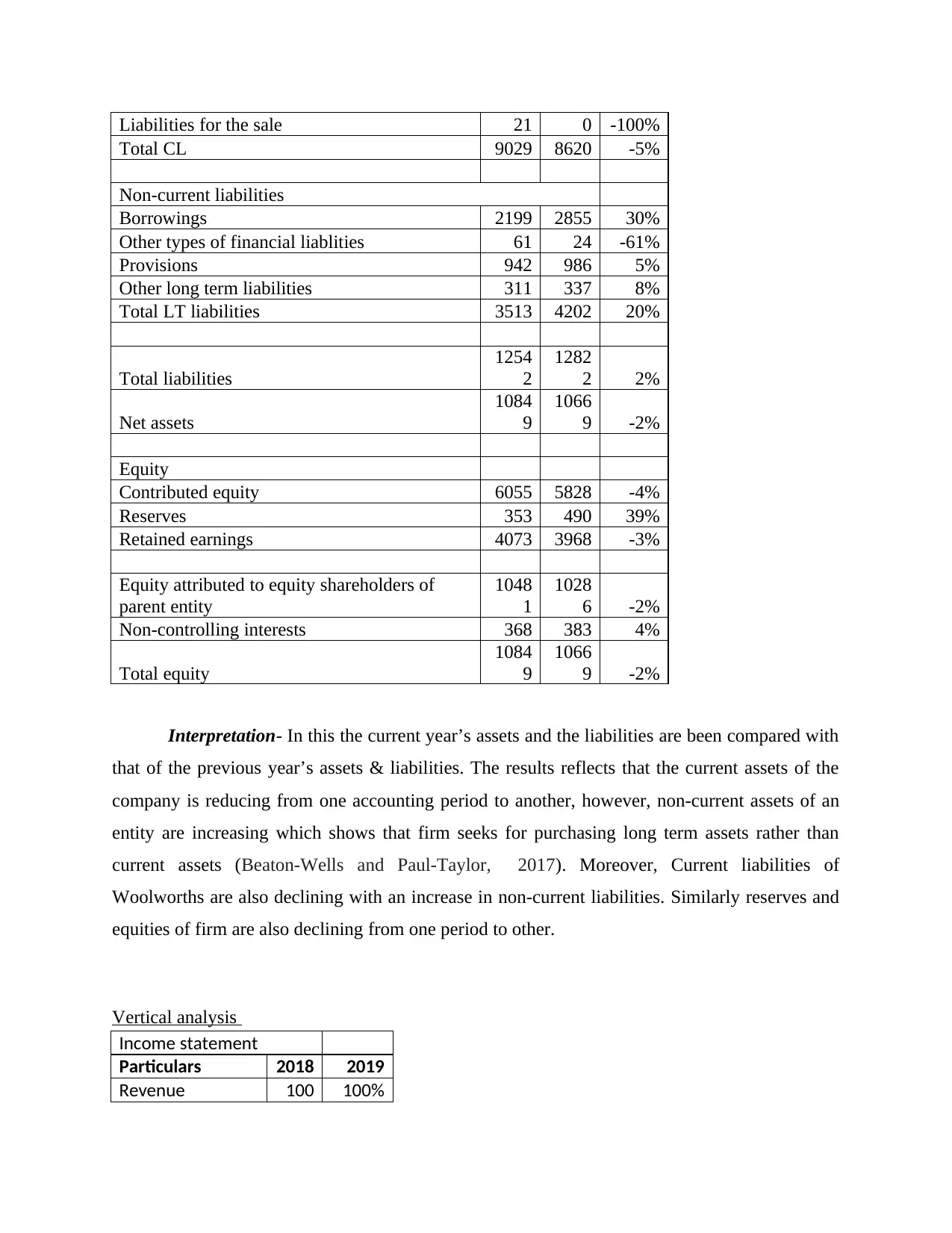
Liabilities for the sale 21 0 -100%
Total CL 9029 8620 -5%
Non-current liabilities
Borrowings 2199 2855 30%
Other types of financial liablities 61 24 -61%
Provisions 942 986 5%
Other long term liabilities 311 337 8%
Total LT liabilities 3513 4202 20%
Total liabilities
1254
2
1282
2 2%
Net assets
1084
9
1066
9 -2%
Equity
Contributed equity 6055 5828 -4%
Reserves 353 490 39%
Retained earnings 4073 3968 -3%
Equity attributed to equity shareholders of
parent entity
1048
1
1028
6 -2%
Non-controlling interests 368 383 4%
Total equity
1084
9
1066
9 -2%
Interpretation- In this the current year’s assets and the liabilities are been compared with
that of the previous year’s assets & liabilities. The results reflects that the current assets of the
company is reducing from one accounting period to another, however, non-current assets of an
entity are increasing which shows that firm seeks for purchasing long term assets rather than
current assets (Beaton-Wells and Paul-Taylor, 2017). Moreover, Current liabilities of
Woolworths are also declining with an increase in non-current liabilities. Similarly reserves and
equities of firm are also declining from one period to other.
Vertical analysis
Income statement
Particulars 2018 2019
Revenue 100 100%
Total CL 9029 8620 -5%
Non-current liabilities
Borrowings 2199 2855 30%
Other types of financial liablities 61 24 -61%
Provisions 942 986 5%
Other long term liabilities 311 337 8%
Total LT liabilities 3513 4202 20%
Total liabilities
1254
2
1282
2 2%
Net assets
1084
9
1066
9 -2%
Equity
Contributed equity 6055 5828 -4%
Reserves 353 490 39%
Retained earnings 4073 3968 -3%
Equity attributed to equity shareholders of
parent entity
1048
1
1028
6 -2%
Non-controlling interests 368 383 4%
Total equity
1084
9
1066
9 -2%
Interpretation- In this the current year’s assets and the liabilities are been compared with
that of the previous year’s assets & liabilities. The results reflects that the current assets of the
company is reducing from one accounting period to another, however, non-current assets of an
entity are increasing which shows that firm seeks for purchasing long term assets rather than
current assets (Beaton-Wells and Paul-Taylor, 2017). Moreover, Current liabilities of
Woolworths are also declining with an increase in non-current liabilities. Similarly reserves and
equities of firm are also declining from one period to other.
Vertical analysis
Income statement
Particulars 2018 2019
Revenue 100 100%

%
Cost of goods sold -71% -71%
Gross profit 29% 29%
Other revenue 0% 0%
Branch expense -19% -19%
Administrative
expense -6% -6%
EBIT 4% 4%
Finance cost 0% 0%
PBT 4% 4%
Income tax
expense -1% -1%
PAT 3% 3%
Interpretation- The table reflects that all the items of profit and loss statement are
assessed over two accounting periods by keeping revenue as the base. It has been identified from
the table that profits of the company remains as stable in 2018 as well as in 2019. This means
that company is generating stable amount of profits with respect to its sales or revenue within the
business.
Balance sheet
Particulars 2018 2019
Current assets
cash 5% 5%
receivables 3% 3%
inventories 18% 18%
Other financial assets 0% 0%
Assets for sale 4% 1%
Total CA 30% 27%
Non-current assets
Receivables 0% 1%
Other financial assets 2% 3%
Plant, property & equipment 39% 41%
Intangible assets 28% 28%
Deferred tax asset 1% 1%
Total non-current asset 70% 73%
Cost of goods sold -71% -71%
Gross profit 29% 29%
Other revenue 0% 0%
Branch expense -19% -19%
Administrative
expense -6% -6%
EBIT 4% 4%
Finance cost 0% 0%
PBT 4% 4%
Income tax
expense -1% -1%
PAT 3% 3%
Interpretation- The table reflects that all the items of profit and loss statement are
assessed over two accounting periods by keeping revenue as the base. It has been identified from
the table that profits of the company remains as stable in 2018 as well as in 2019. This means
that company is generating stable amount of profits with respect to its sales or revenue within the
business.
Balance sheet
Particulars 2018 2019
Current assets
cash 5% 5%
receivables 3% 3%
inventories 18% 18%
Other financial assets 0% 0%
Assets for sale 4% 1%
Total CA 30% 27%
Non-current assets
Receivables 0% 1%
Other financial assets 2% 3%
Plant, property & equipment 39% 41%
Intangible assets 28% 28%
Deferred tax asset 1% 1%
Total non-current asset 70% 73%
Secure Best Marks with AI Grader
Need help grading? Try our AI Grader for instant feedback on your assignments.
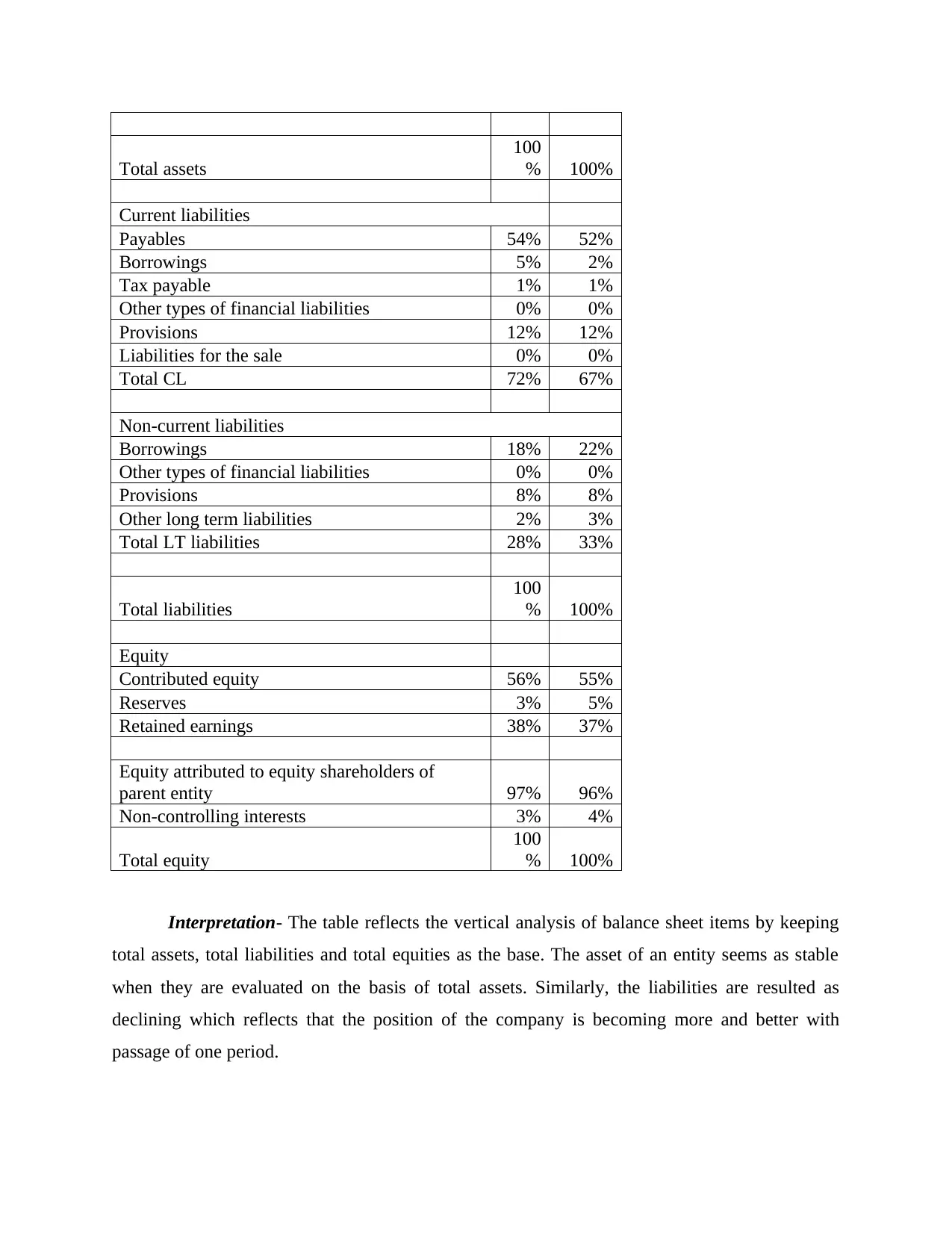
Total assets
100
% 100%
Current liabilities
Payables 54% 52%
Borrowings 5% 2%
Tax payable 1% 1%
Other types of financial liabilities 0% 0%
Provisions 12% 12%
Liabilities for the sale 0% 0%
Total CL 72% 67%
Non-current liabilities
Borrowings 18% 22%
Other types of financial liabilities 0% 0%
Provisions 8% 8%
Other long term liabilities 2% 3%
Total LT liabilities 28% 33%
Total liabilities
100
% 100%
Equity
Contributed equity 56% 55%
Reserves 3% 5%
Retained earnings 38% 37%
Equity attributed to equity shareholders of
parent entity 97% 96%
Non-controlling interests 3% 4%
Total equity
100
% 100%
Interpretation- The table reflects the vertical analysis of balance sheet items by keeping
total assets, total liabilities and total equities as the base. The asset of an entity seems as stable
when they are evaluated on the basis of total assets. Similarly, the liabilities are resulted as
declining which reflects that the position of the company is becoming more and better with
passage of one period.
100
% 100%
Current liabilities
Payables 54% 52%
Borrowings 5% 2%
Tax payable 1% 1%
Other types of financial liabilities 0% 0%
Provisions 12% 12%
Liabilities for the sale 0% 0%
Total CL 72% 67%
Non-current liabilities
Borrowings 18% 22%
Other types of financial liabilities 0% 0%
Provisions 8% 8%
Other long term liabilities 2% 3%
Total LT liabilities 28% 33%
Total liabilities
100
% 100%
Equity
Contributed equity 56% 55%
Reserves 3% 5%
Retained earnings 38% 37%
Equity attributed to equity shareholders of
parent entity 97% 96%
Non-controlling interests 3% 4%
Total equity
100
% 100%
Interpretation- The table reflects the vertical analysis of balance sheet items by keeping
total assets, total liabilities and total equities as the base. The asset of an entity seems as stable
when they are evaluated on the basis of total assets. Similarly, the liabilities are resulted as
declining which reflects that the position of the company is becoming more and better with
passage of one period.
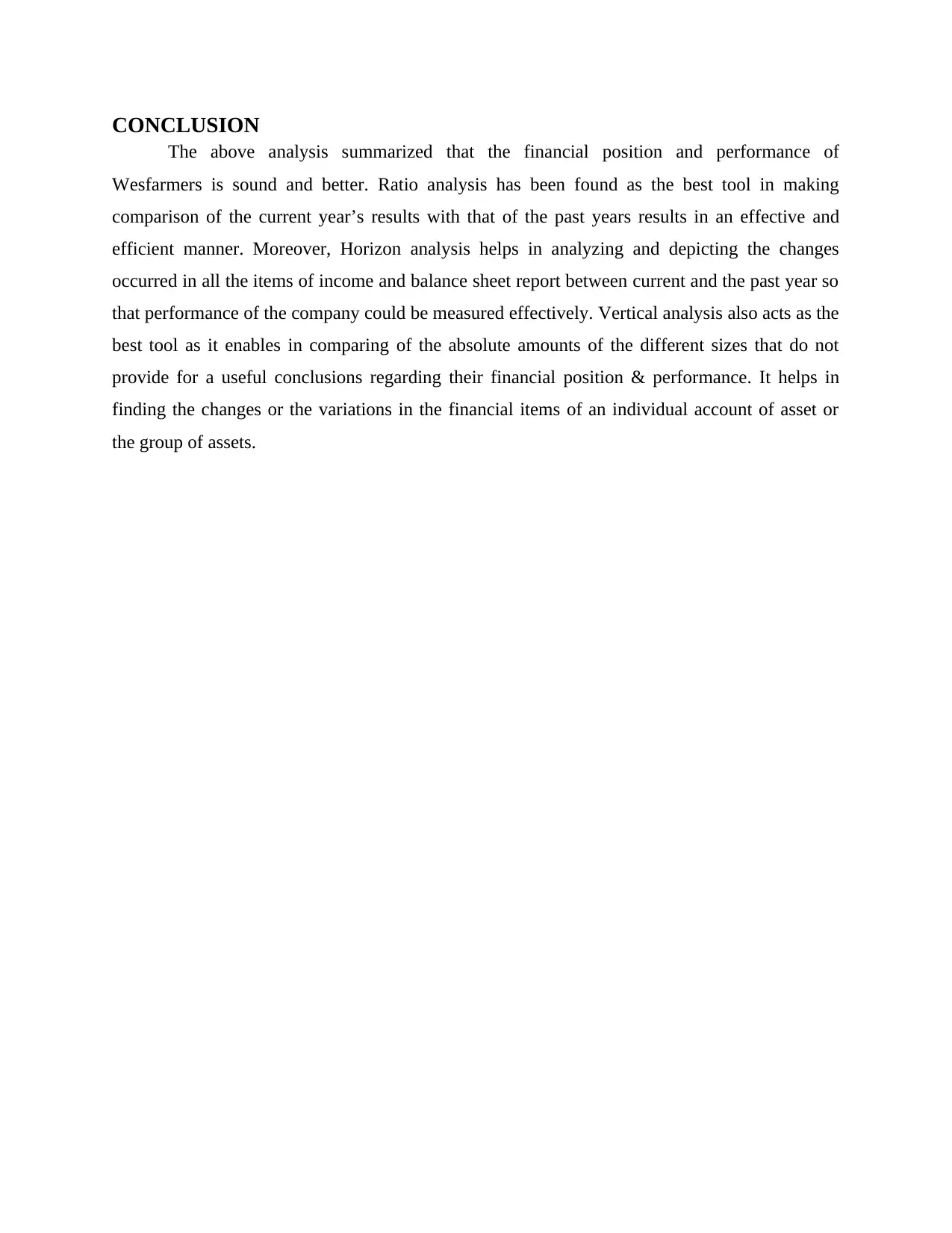
CONCLUSION
The above analysis summarized that the financial position and performance of
Wesfarmers is sound and better. Ratio analysis has been found as the best tool in making
comparison of the current year’s results with that of the past years results in an effective and
efficient manner. Moreover, Horizon analysis helps in analyzing and depicting the changes
occurred in all the items of income and balance sheet report between current and the past year so
that performance of the company could be measured effectively. Vertical analysis also acts as the
best tool as it enables in comparing of the absolute amounts of the different sizes that do not
provide for a useful conclusions regarding their financial position & performance. It helps in
finding the changes or the variations in the financial items of an individual account of asset or
the group of assets.
The above analysis summarized that the financial position and performance of
Wesfarmers is sound and better. Ratio analysis has been found as the best tool in making
comparison of the current year’s results with that of the past years results in an effective and
efficient manner. Moreover, Horizon analysis helps in analyzing and depicting the changes
occurred in all the items of income and balance sheet report between current and the past year so
that performance of the company could be measured effectively. Vertical analysis also acts as the
best tool as it enables in comparing of the absolute amounts of the different sizes that do not
provide for a useful conclusions regarding their financial position & performance. It helps in
finding the changes or the variations in the financial items of an individual account of asset or
the group of assets.
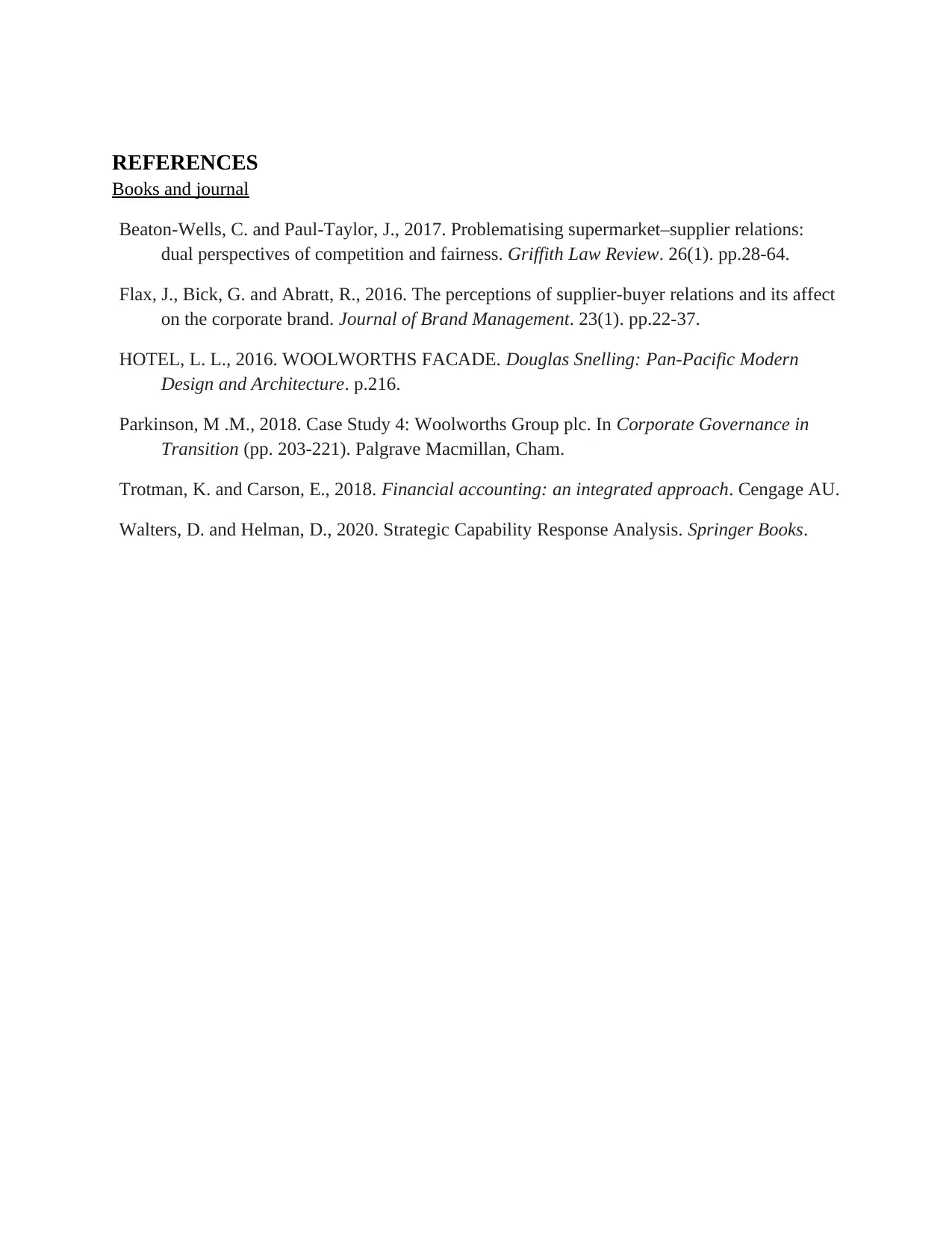
REFERENCES
Books and journal
Beaton-Wells, C. and Paul-Taylor, J., 2017. Problematising supermarket–supplier relations:
dual perspectives of competition and fairness. Griffith Law Review. 26(1). pp.28-64.
Flax, J., Bick, G. and Abratt, R., 2016. The perceptions of supplier-buyer relations and its affect
on the corporate brand. Journal of Brand Management. 23(1). pp.22-37.
HOTEL, L. L., 2016. WOOLWORTHS FACADE. Douglas Snelling: Pan-Pacific Modern
Design and Architecture. p.216.
Parkinson, M .M., 2018. Case Study 4: Woolworths Group plc. In Corporate Governance in
Transition (pp. 203-221). Palgrave Macmillan, Cham.
Trotman, K. and Carson, E., 2018. Financial accounting: an integrated approach. Cengage AU.
Walters, D. and Helman, D., 2020. Strategic Capability Response Analysis. Springer Books.
Books and journal
Beaton-Wells, C. and Paul-Taylor, J., 2017. Problematising supermarket–supplier relations:
dual perspectives of competition and fairness. Griffith Law Review. 26(1). pp.28-64.
Flax, J., Bick, G. and Abratt, R., 2016. The perceptions of supplier-buyer relations and its affect
on the corporate brand. Journal of Brand Management. 23(1). pp.22-37.
HOTEL, L. L., 2016. WOOLWORTHS FACADE. Douglas Snelling: Pan-Pacific Modern
Design and Architecture. p.216.
Parkinson, M .M., 2018. Case Study 4: Woolworths Group plc. In Corporate Governance in
Transition (pp. 203-221). Palgrave Macmillan, Cham.
Trotman, K. and Carson, E., 2018. Financial accounting: an integrated approach. Cengage AU.
Walters, D. and Helman, D., 2020. Strategic Capability Response Analysis. Springer Books.
1 out of 13
Related Documents
Your All-in-One AI-Powered Toolkit for Academic Success.
+13062052269
info@desklib.com
Available 24*7 on WhatsApp / Email
![[object Object]](/_next/static/media/star-bottom.7253800d.svg)
Unlock your academic potential
© 2024 | Zucol Services PVT LTD | All rights reserved.





